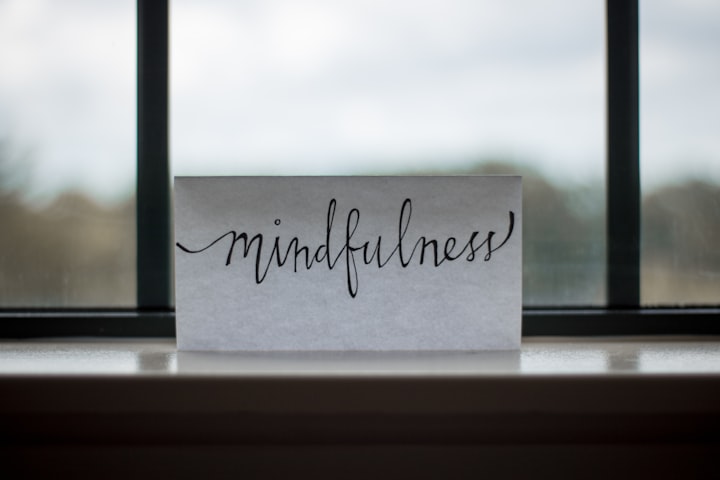The Top 10 Must-Try Wellness Trends of the Year
TRENDING WELLNESS

Sure! Here is a potential outline for an article titled "The Top 10 Must-Try Wellness Trends of the Year":
Mindfulness and meditation:
Mindfulness is the practice of bringing one's attention to the present moment, without judgment. It involves paying attention to one's thoughts and feelings in a non-reactive way, and can be practiced through activities such as meditation, yoga, and breathing exercises.
Meditation is a practice that involves focusing the mind on a particular object, thought, or activity to achieve a state of heightened awareness and relaxation. There are many different types of meditation, including mindfulness meditation, loving-kindness meditation, and transcendental meditation.
Both mindfulness and meditation have been shown to have numerous benefits for mental and physical health. Some of these benefits include:
Reducing stress and anxiety
Improving sleep
Decreasing symptoms of depression
Lowering blood pressure
Improving focus and concentration
Enhancing self-awareness
Increasing feelings of calm and relaxation
There are many ways to incorporate mindfulness and meditation into one's daily routine, such as setting aside time for a daily meditation practice, taking mindful breaks throughout the day, or incorporating mindfulness techniques into activities such as eating and walking. There are also many resources available to help people get started with mindfulness and meditation, such as guided meditations, apps, and classes.
Plant-based eating:
Plant-based eating involves consuming a diet that is primarily made up of plants, including vegetables, fruits, whole grains, legumes, nuts, and seeds. It can also include plant-based sources of protein, such as tofu and tempeh, as well as plant-based milks, such as almond milk and soy milk. Plant-based eating can be followed for a variety of reasons, including personal health, environmental sustainability, and animal welfare.
There are several different types of plant-based diets, including:
Vegan: A vegan diet includes only plant-based foods and excludes all animal products, including meat, poultry, fish, eggs, and dairy.
Vegetarian: A vegetarian diet includes plant-based foods, as well as eggs and dairy, but excludes meat, poultry, and fish.
Pescatarian: A pescatarian diet includes plant-based foods, as well as eggs, dairy, and fish, but excludes meat and poultry.
Flexitarian: A flexitarian diet is mostly plant-based, but also includes small amounts of animal products.
Plant-based eating has been shown to have numerous health benefits, including a lower risk of heart disease, high blood pressure, and type 2 diabetes. It can also be more environmentally sustainable than a diet that includes a lot of animal products, as the production of plant-based foods typically requires fewer natural resources.
If you are considering transitioning to a plant-based diet, it is important to ensure that you are getting all of the nutrients your body needs. This may involve carefully planning your meals to include a variety of plant-based sources of protein, as well as getting enough iron, calcium, and vitamin B12. A registered dietitian can help you create a well-balanced plant-based diet that meets your nutritional needs.
Virtual fitness classes:
Virtual fitness classes are online exercise classes that are led by a instructor and can be accessed via a computer, smartphone, or other device with an internet connection. They offer a convenient and flexible way to work out, as they can be accessed from anywhere and do not require a trip to a gym or studio.
There are many different types of virtual fitness classes available, including yoga, Pilates, cardio, strength training, and dance. Some virtual fitness classes are live and occur at a specific time, while others are pre-recorded and can be accessed at any time. Many virtual fitness classes are offered through apps or websites that require a subscription, while others are available for free or on a pay-per-class basis.
Virtual fitness classes have several benefits, including:
Convenience: They can be accessed from anywhere with an internet connection, allowing you to work out on your own schedule.
Variety: There are many different types of virtual fitness classes available, so you can try out different workouts and find what works best for you.
Cost-effective: Many virtual fitness classes are more affordable than in-person classes or gym memberships.
Personalized instruction: Some virtual fitness classes offer the option for one-on-one coaching or personalized workout plans.
To get started with virtual fitness classes, you will need a device with an internet connection and a space to work out. You may also want to invest in some basic equipment, such as a yoga mat or dumbbells, depending on the type of workouts you choose. It is also a good idea to do some research and find a virtual fitness class platform or instructor that aligns with your goals and preferences.
Self-care practices:
Self-care practices are activities that individuals engage in to take care of their physical, mental, and emotional well-being. They can help reduce stress, improve mood, and increase overall feelings of happiness and contentment. Some examples of self-care practices include:
Exercise and physical activity
Getting enough sleep
Eating a healthy diet
Practicing relaxation techniques, such as meditation or deep breathing
Spending time in nature
Engaging in hobbies or activities that bring joy
Setting boundaries and saying no to commitments that are not a priority
Seeking professional help, such as therapy or counseling
It is important to make self-care a regular part of your routine in order to prioritize your well-being and maintain a healthy balance in your life. It is also important to remember that self-care looks different for everyone, so it is important to find activities that work for you and that you enjoy. Some people may find self-care practices such as exercise and meditation to be beneficial, while others may find that activities such as reading or cooking bring them joy and help them relax.
Incorporating self-care practices into your daily routine can be as simple as setting aside time for an activity that brings you joy or taking a few minutes to practice deep breathing or mindfulness. It is also important to be mindful of your own needs and to make self-care a priority in your life.
Natural and alternative remedies:
Natural and alternative remedies are treatments or therapies that are not part of mainstream Western medicine and that are typically derived from natural sources. They are often used to treat a wide range of conditions, including chronic pain, anxiety, and insomnia. Some examples of natural and alternative remedies include:
Herbal remedies: Herbs are plants that are used for their medicinal properties. They can be taken as supplements, teas, or tinctures.
Acupuncture: Acupuncture is a form of traditional Chinese medicine that involves the insertion of thin needles into specific points on the body to relieve pain and promote healing.
Chiropractic care: Chiropractic care is a form of alternative medicine that focuses on the treatment of musculoskeletal disorders through manual adjustments to the spine and other joints.
Massage therapy: Massage therapy involves the use of hands-on techniques to manipulate the soft tissues of the body to promote relaxation and reduce muscle tension.
Aromatherapy: Aromatherapy is the use of essential oils from plants to promote physical and emotional well-being.
It is important to note that natural and alternative remedies are not always supported by scientific evidence and may not be effective for everyone. It is always a good idea to speak with a healthcare provider before starting any new treatment or therapy, particularly if you are taking medications or have a chronic medical condition. A healthcare provider can help you determine if a natural or alternative remedy is safe and appropriate for you.
Sleep hygiene:
Sleep hygiene is a term used to describe the habits and practices that can promote healthy sleep. Good sleep hygiene is essential for getting a good night's sleep and can help improve sleep quality, as well as overall physical and mental health.
Here are some tips for improving sleep hygiene:
Establish a regular sleep schedule: Try to go to bed and wake up at the same time every day, even on weekends.
Create a sleep-friendly environment: Keep your bedroom dark, cool, and quiet. Use a comfortable mattress and pillows.
Limit exposure to screens before bedtime: The blue light emitted by screens can disrupt the production of the sleep hormone melatonin, so it is a good idea to avoid screens for at least an hour before bedtime.
Avoid caffeine and alcohol before bedtime: Caffeine and alcohol can interfere with sleep, so it is best to avoid them for at least a few hours before bedtime.
Exercise regularly: Regular physical activity can help improve sleep quality, but it is best to avoid vigorous exercise close to bedtime.
Relax before bedtime: Engaging in relaxation techniques such as meditation, deep breathing, or reading can help you wind down and prepare for sleep.
Consider using white noise: If you are sensitive to noise or have a partner who snores, using a white noise machine or app can help block out distractions and improve sleep.
It is also a good idea to see a healthcare provider if you are having difficulty sleeping, as there may be an underlying medical condition that is causing your sleep problems. A healthcare provider can help determine the cause of your sleep issues and recommend appropriate treatment options.
Cryotherapy:
Cryotherapy is a treatment that involves exposing the body to extremely cold temperatures in order to promote healing and recovery. It is often used to treat muscle and joint pain, as well as inflammation.
There are several different types of cryotherapy, including:
Whole body cryotherapy (WBC): WBC involves standing in a chamber that is cooled to extremely low temperatures (usually around -200 to -300 degrees Fahrenheit) for a short period of time (typically 2-4 minutes).
Localized cryotherapy: Localized cryotherapy involves applying cold therapy to a specific area of the body using a cryotherapy device or ice pack.
Cryotherapy facials: Cryotherapy facials involve exposing the face to extremely cold temperatures in order to tighten and firm the skin.
Cryotherapy is thought to work by constricting blood vessels and reducing inflammation, which can help reduce pain and improve recovery time. It is also thought to boost the immune system and promote the release of endorphins, which are chemicals that can improve mood and reduce pain.
Cryotherapy is generally considered to be safe, although it is not recommended for people with certain conditions, such as Raynaud's disease, cold urticaria, and certain cardiovascular conditions. It is always a good idea to speak with a healthcare provider before starting cryotherapy to determine if it is appropriate for you.
CBD-based products:
CBD, or cannabidiol, is a chemical compound found in the cannabis plant. It is one of many compounds called cannabinoids that are found in cannabis. Unlike THC (tetrahydrocannabinol), another cannabinoid, CBD is not psychoactive, which means it does not produce a "high" when consumed.
CBD-based products are products that contain CBD and are used for a variety of purposes, including relieving pain, reducing anxiety and depression, and improving sleep. These products can be derived from the hemp plant or the marijuana plant and come in many forms, including oils, tinctures, edibles, creams, and more.
Some people use CBD-based products to help with specific health conditions, while others use them for general wellness purposes. It is important to note that the use of CBD-based products is not currently supported by all mainstream medical organizations, and the evidence for their effectiveness is not yet strong. More research is needed to fully understand the potential benefits and risks of CBD-based products.
It is always a good idea to speak with a healthcare provider before starting to use CBD-based products, as they may interact with certain medications or have other potential risks or side effects. It is also important to choose high-quality products that have been lab tested to ensure they contain the amount of CBD listed on the label.
Virtual therapy:
Virtual therapy, also known as teletherapy or online therapy, is the delivery of mental health services through a video conference or phone call. It allows individuals to receive therapy from a licensed therapist remotely, rather than in person.
Virtual therapy can be an effective treatment option for a variety of mental health conditions, including depression, anxiety, and post-traumatic stress disorder (PTSD). It can also be a convenient option for people who have difficulty traveling to a therapist's office or who live in areas with a shortage of mental health providers.
Virtual therapy sessions are typically conducted through a secure video platform or phone call and may involve talking with a therapist about your thoughts, feelings, and behaviors. The therapist may also provide you with coping strategies, support, and guidance to help you manage your mental health.
To get started with virtual therapy, you will need to find a therapist who offers this service and schedule an appointment. Many therapists offer a free initial consultation to determine if virtual therapy is right for you. It is important to choose a therapist who is licensed in your state and who has the appropriate experience and training to meet your needs.
Eco-friendly products:
Eco-friendly products are products that are designed and produced with the goal of having a minimal impact on the environment. They are often made from natural or sustainable materials and are produced using environmentally-friendly processes.
There are many different types of eco-friendly products available, including:
Organic and natural personal care products: These are products that are made from natural ingredients and are free of synthetic chemicals that may be harmful to the environment or to human health.
Reusable shopping bags: These are bags that can be used multiple times instead of disposable plastic bags.
Eco-friendly cleaning products: These are products that are made with natural ingredients and do not contain harmful chemicals that can pollute the environment.
Energy-efficient appliances: These appliances use less energy than traditional appliances and can help reduce greenhouse gas emissions.
Recycled or sustainable products: These products are made from recycled materials or sustainable resources, such as bamboo or hemp.
Eco-friendly products can help reduce waste and minimize the environmental impact of consumerism. They may also have health benefits, as many eco-friendly products are made with natural ingredients and do not contain harmful chemicals. When shopping for eco-friendly products, it is important to carefully read labels and do your research to ensure that the products you are considering are truly environmentally-friendly.






Comments
There are no comments for this story
Be the first to respond and start the conversation.